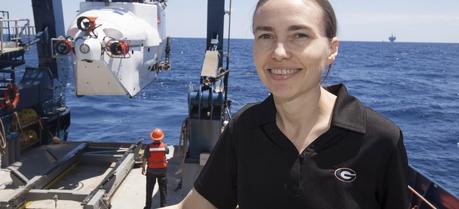 Samantha Joye, a professor of marine sciences in the Franklin College of Arts and Sciences, studies the oil plumes generated by the 2010 Deepwater Horizon blowout. (Credit: University of Georgia)
Samantha Joye, a professor of marine sciences in the Franklin College of Arts and Sciences, studies the oil plumes generated by the 2010 Deepwater Horizon blowout. (Credit: University of Georgia)The 2010 Deepwater Horizon blowout discharged roughly five million barrels of oil and up to 500,000 tons of natural gas into Gulf of Mexico offshore waters over a period of 84 days. In the face of a seemingly insurmountable cleanup effort, many were relieved by reports following the disaster that naturally-occurring microbes had consumed much of the gas and oil.
Now, a team of researchers led by University of Georgia marine scientists have published a paper in the journal Nature Geoscience (see footnote) that questions this conclusion and provides evidence that methane-oxidizing microbes may not be capable of removing contaminants as quickly and easily as once thought.
“Most of the gas injected into the Gulf was methane, a potent greenhouse gas that contributes to global climate change, so we were naturally concerned that this potent greenhouse gas could escape into the atmosphere,” said Samantha Joye, senior author of the paper, director of the study and professor of marine science in UGA’s Franklin College of Arts and Sciences. “Many assumed that methane-oxidizing microbes would simply consume the methane efficiently, but our data suggests that this isn’t what happened.”
Joye and colleagues from other universities and government organizations measured methane concentrations and the activity of methane-consuming bacteria for ten months, starting before the blowout with collection of an invaluable set of pre-discharge samples taken in March 2010.
The abundance of methane in the water allowed the methane-oxidizing microbes that feed on the gas to flourish in the first two months immediately following the blowout, but their activity levels dropped abruptly despite the fact that methane was still being released from the wellhead.
This new data suggests the sudden drop in bacterial activity was not due to an absence of methane, but a host of environmental, physiological, and physical constraints that made it difficult or impossible for bacteria to consume methane effectively.
“For these bacteria to work efficiently, they need unlimited access to nutrients like inorganic nitrogen and trace metals, but they also need elevated methane levels to persist long enough to support high rates of consumption,” Joye said. “The bacteria in the Gulf were probably able to consume about half of the methane released, but we hypothesize that an absence of essential nutrients and the dispersal of gas throughout the water column prevented complete consumption of the discharged methane.”
Joye insists that while her group’s conclusions differ from those presented in previous studies, there is no serious conflict between their analyses.
“The issue here was short-term sampling versus long-term time series sampling,” she said. “I hope our paper clearly relays the message that long-term sampling is the only way to capture the evolution of a natural system as it responds to large perturbations like oil well blowouts or any other abrupt methane release.”
Ultimately, scientists need to better understand the behavior of these microbes so that they may better gauge the environmental impacts of future accidents and methane releases due to climate change, she said.
“It’s only a matter of time before we face another serious incident like Deepwater Horizon,” Joye said. “The key is understanding the things that regulate how fast bacteria can consume methane, and that will give us insight into the ultimate fate of this potent greenhouse gas in our oceans.”
Support for this study includes funding from the National Oceanic and Atmospheric Administration, the U.S. Department of Energy, the National Science Foundation and the Gulf of Mexico Research Initiative.
Crespo-Medina, M., Meile, C., Hunter, K., Diercks, A., Asper, V., Orphan, V., Tavormina, P., Nigro, L., Battles, J., Chanton, J., Shiller, A., Joung, D., Amon, R., Bracco, A., Montoya, J., Villareal, T., Wood, A., & Joye, S. (2014). The rise and fall of methanotrophy following a deepwater oil-well blowout Nature Geoscience DOI: 10.1038/ngeo2156
